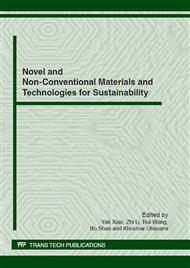p.628
p.635
p.646
p.653
p.661
p.669
p.677
p.683
p.689
Fracture Toughness of Northeast China Larch
Abstract:
Wood, as a green and environment-friendly building material, is widely used in building engineering. Naturally grown, wood has various defects like knots, cracks and inclined grain. Fracture Mechanics is thus an efficient tool to investigate the mechanical behavior of wood and wood-based composite products. According to Linear-elastic Fracture Mechanics (LEFM), fracture toughness can be introduced to measure the resistance to crack propagation. Crack was assumed to occur when the stress intensity factor K reached a critical value KC. Fracture in wood usually involves not only the Mode I type (open) fracture, but also the Mode II type (shear) fracture. For getting a better understanding of the crack growth phenomenon of Northeast China Larch, it is, therefore, essential to assess the KIC and KIIC, which are the critical stress intensity factors for Mode I and Mode II type fracture, respectively. In the current study, KIC and KIIC, of Northeast China Larch were determined through tests with compact tension specimens and tests with compact symmetric shear specimens, respectively. In addition, the material properties tests were also performed. All of the specimens were cut from the same batch of Glulam beams. Based on the obtained data from experiments, LEFM was employed to explain the fracture failure in the form of crack propagation. Using Extended Finite Element Method (XFEM), simulation of the crack propagation in Mode I and Mode II was performed incorporating ABAQUS. The crack propagation and the load-displacement curves of numerical simulation were in good agreement with experiments, which validated that the proposed numerical approach is suitable for analysis of crack growth in the specimens. As part of a larger program to investigate the fracture behavior of Glulam beams made of Northeast China Larch, this study provides the material properties and validation of the numerical simulation approach. A series of experiments of full-size curved Glulam beams subject to bending and the corresponding simulations extending the numerical approach of this study to the cases of full-size wood composite members are under development.
Info:
Periodical:
Pages:
661-668
Citation:
Online since:
June 2012
Authors:
Keywords:
Price:
Сopyright:
© 2012 Trans Tech Publications Ltd. All Rights Reserved
Share:
Citation:


